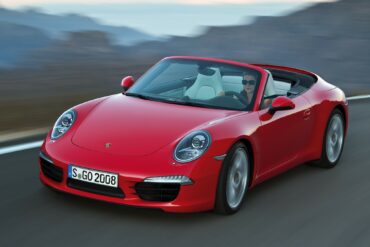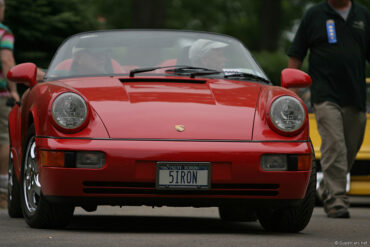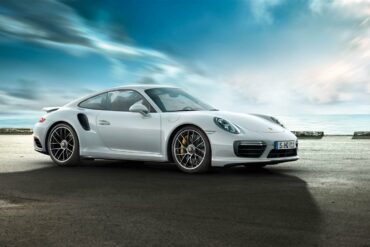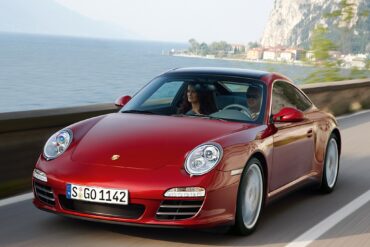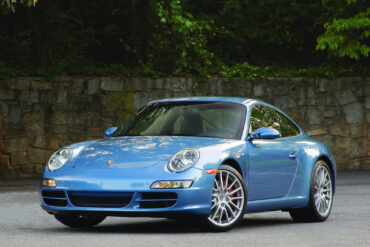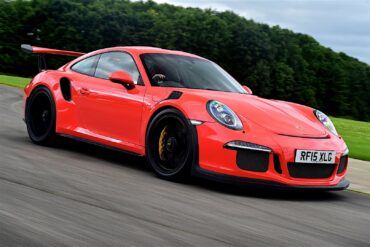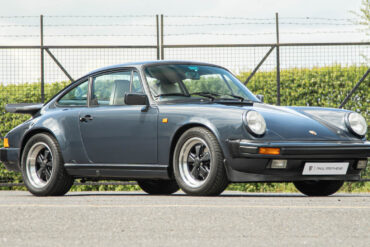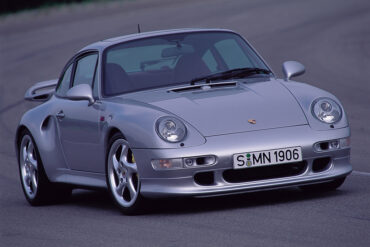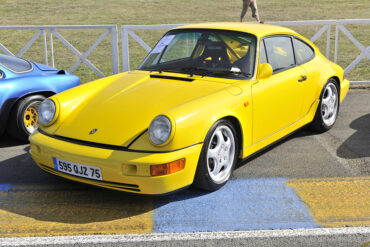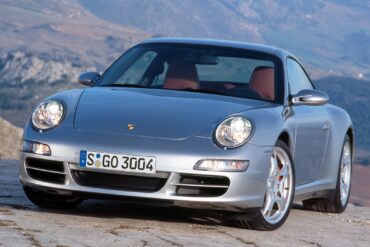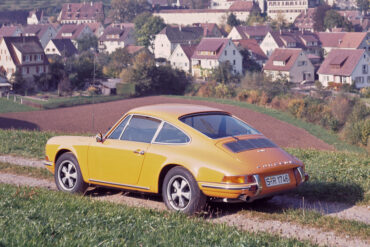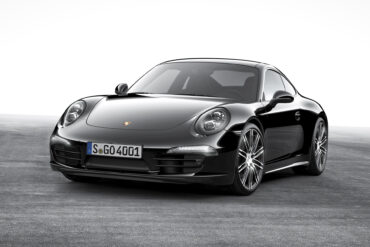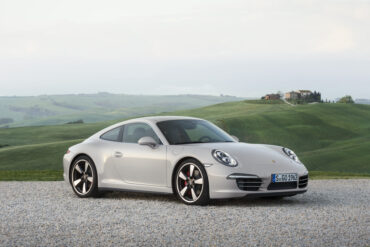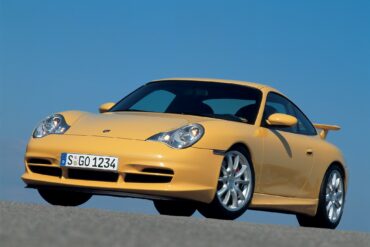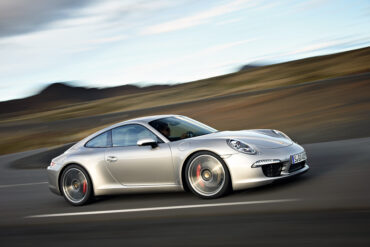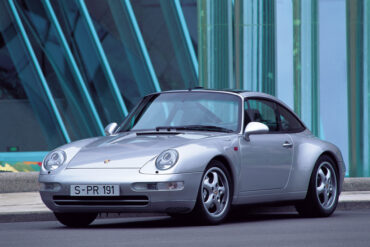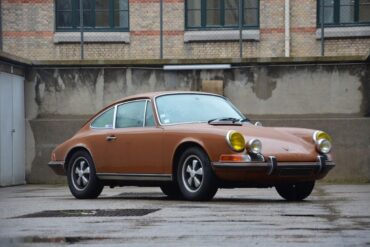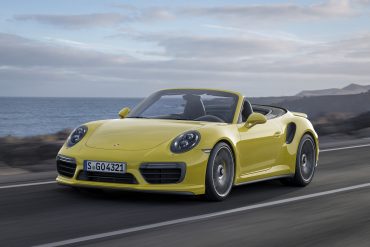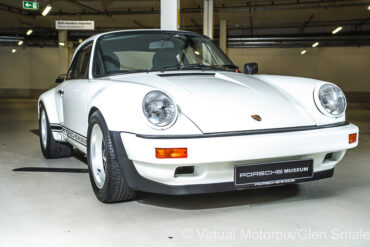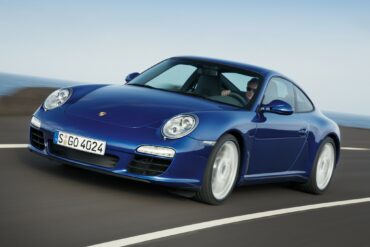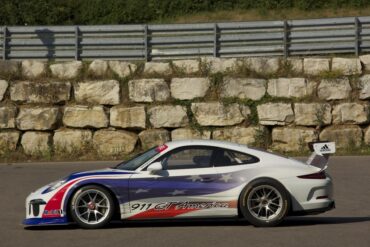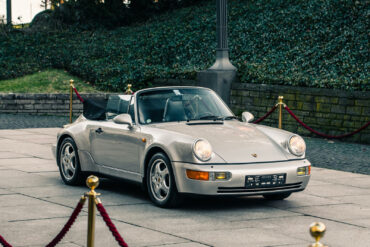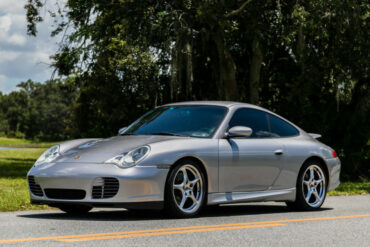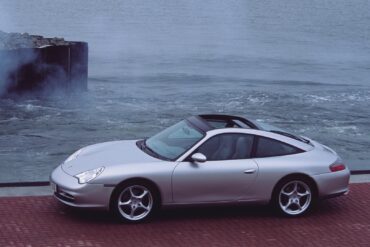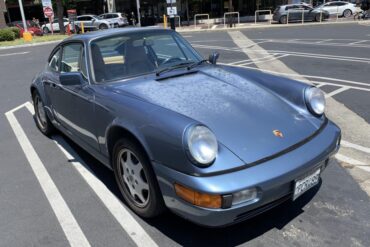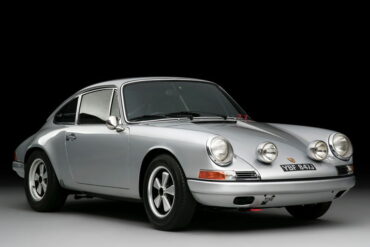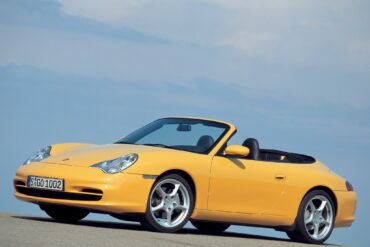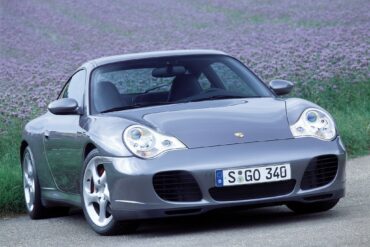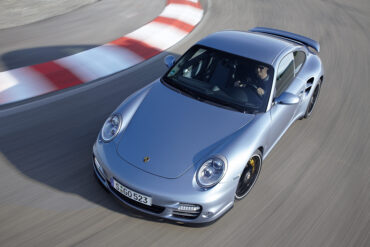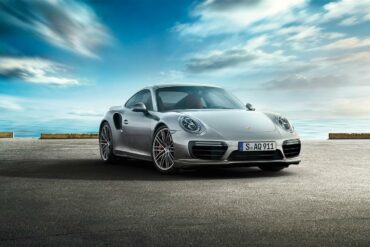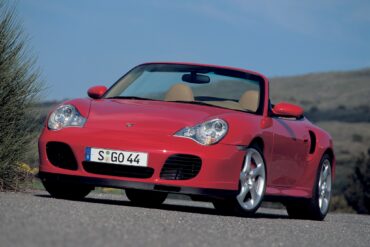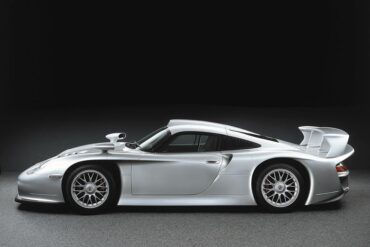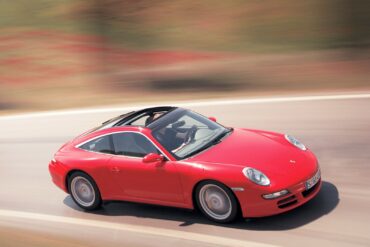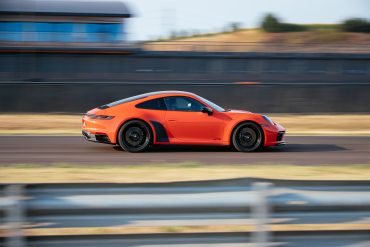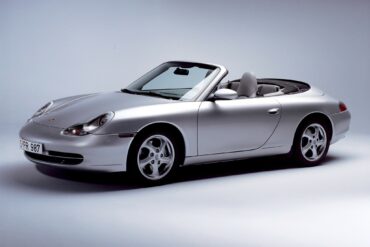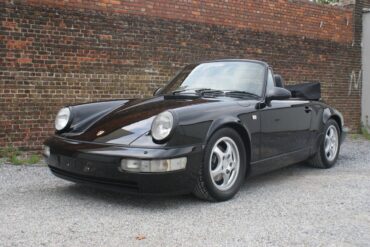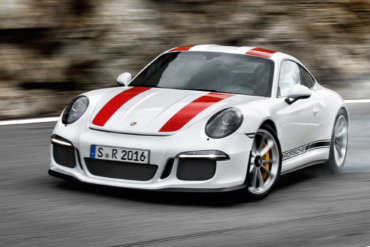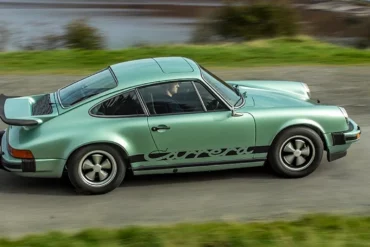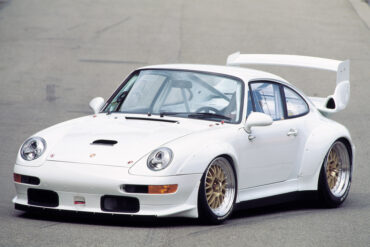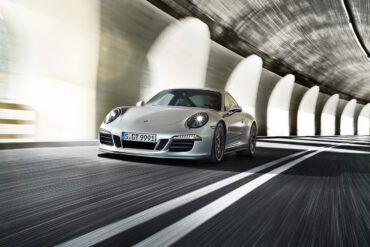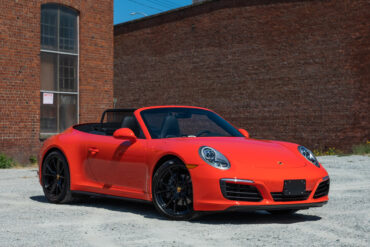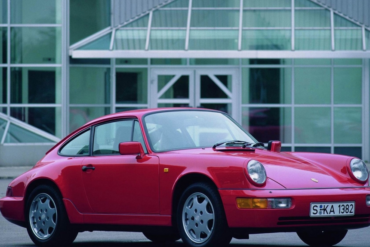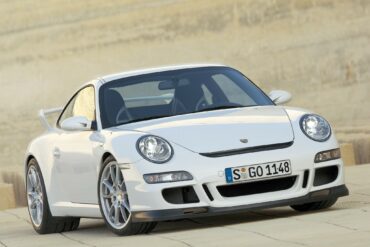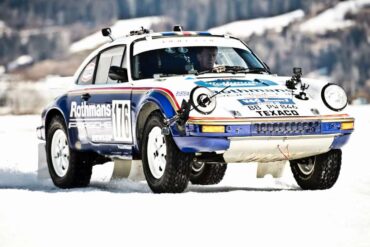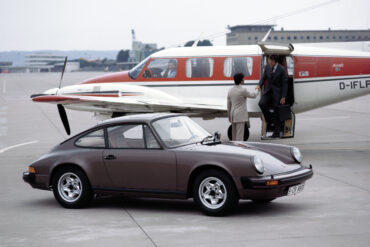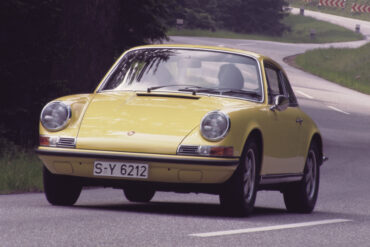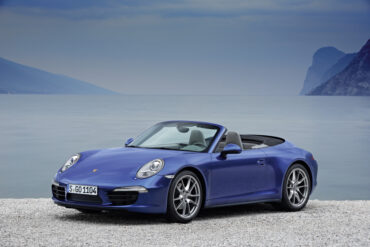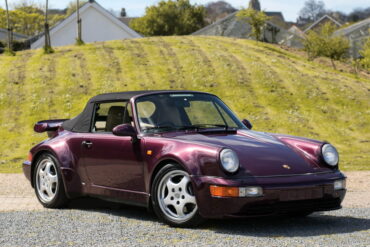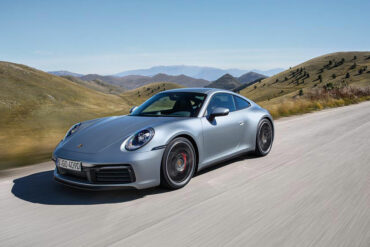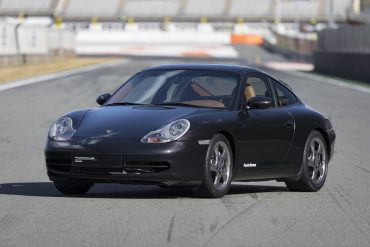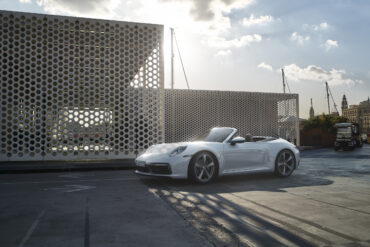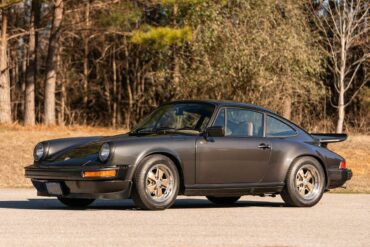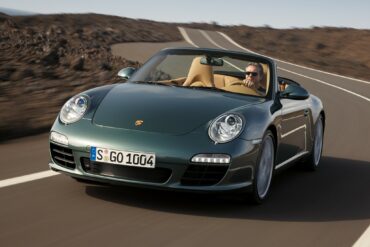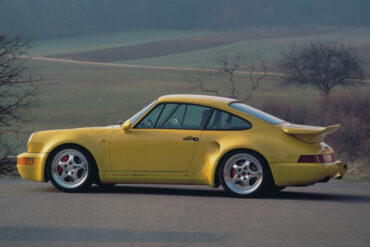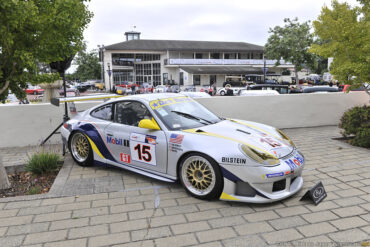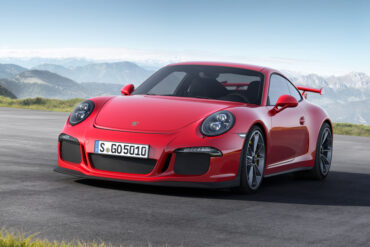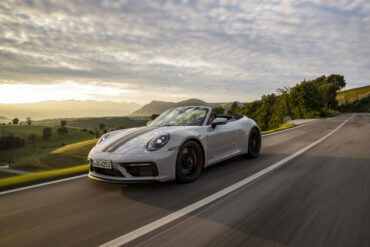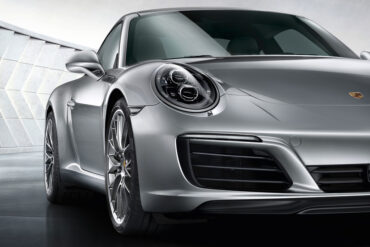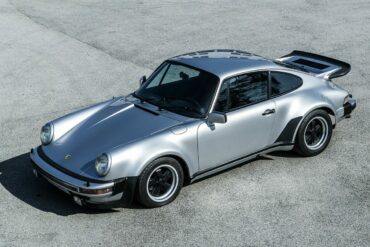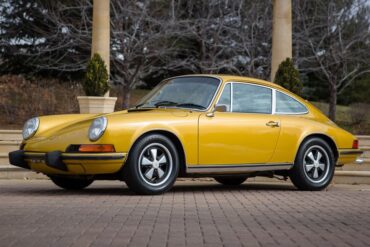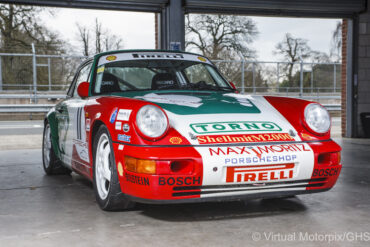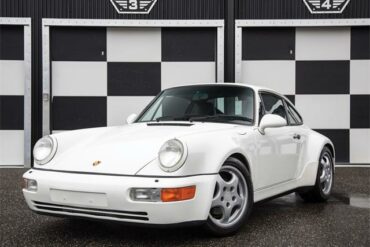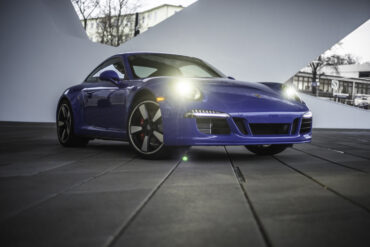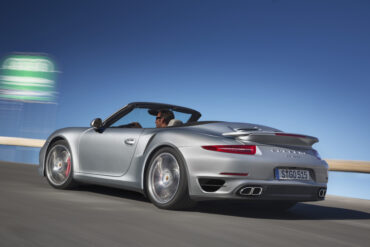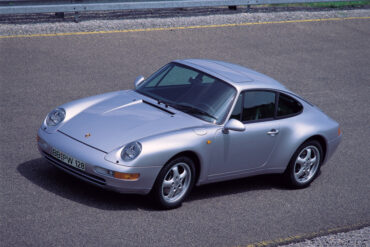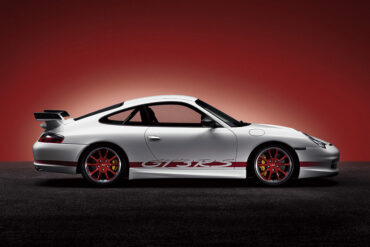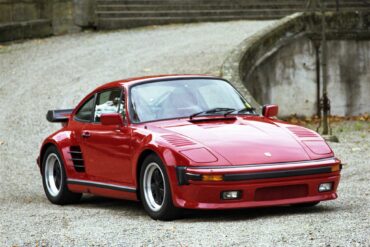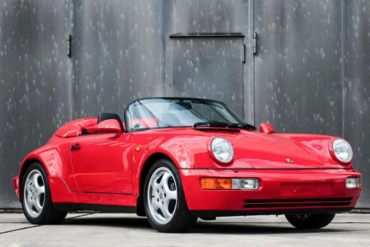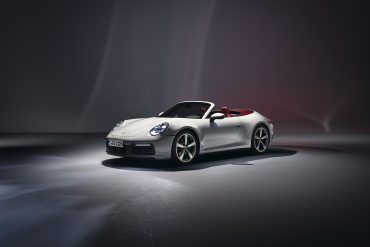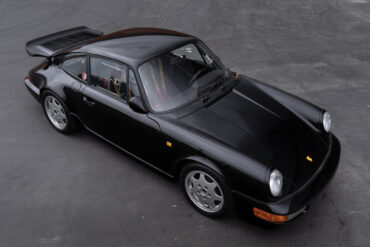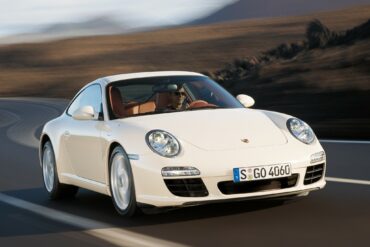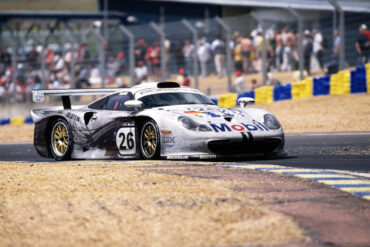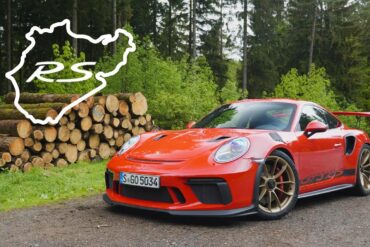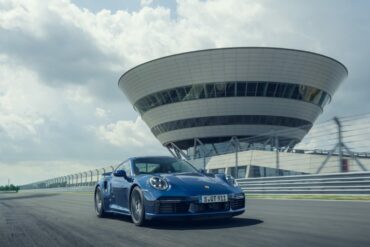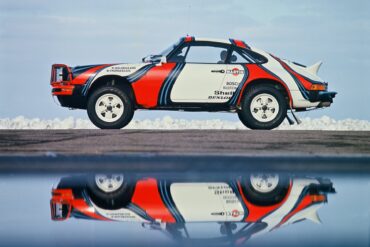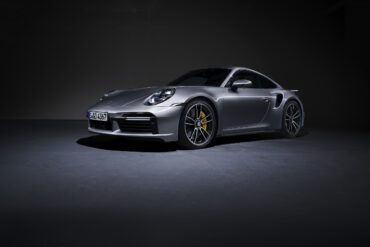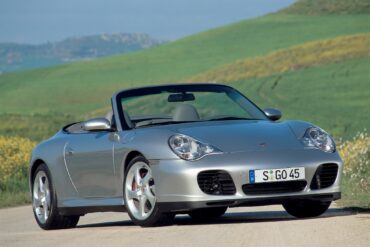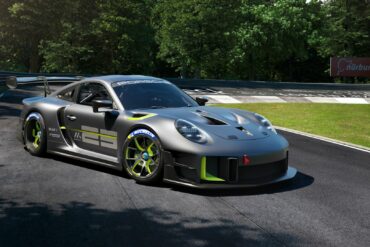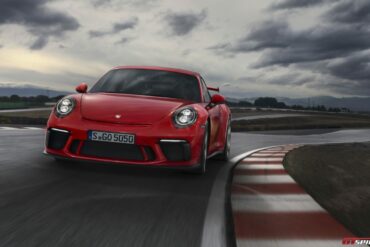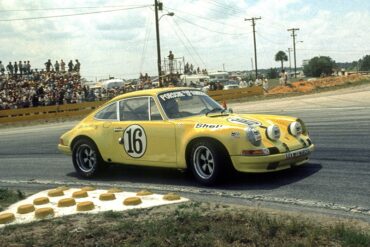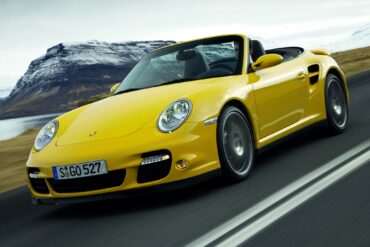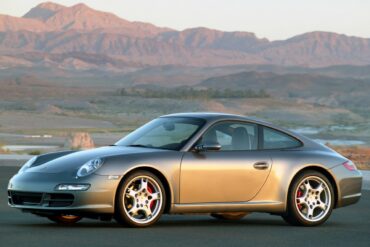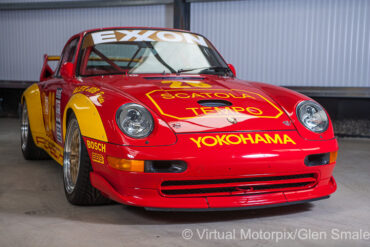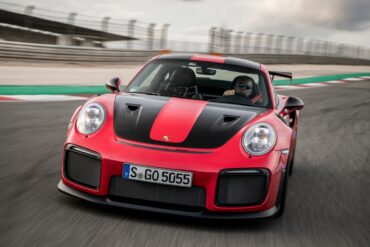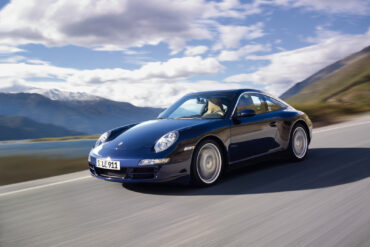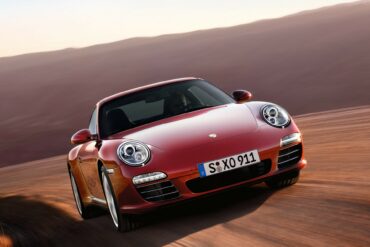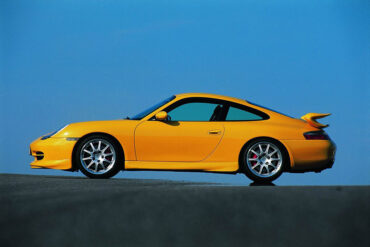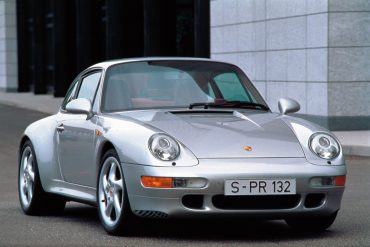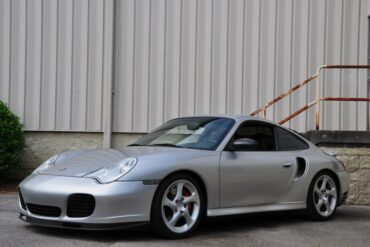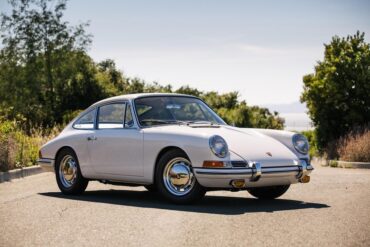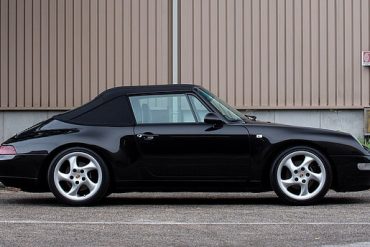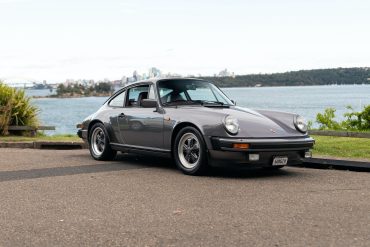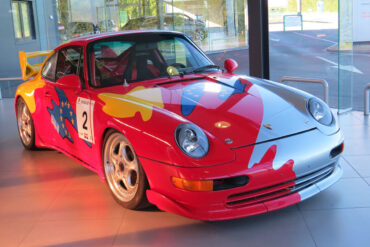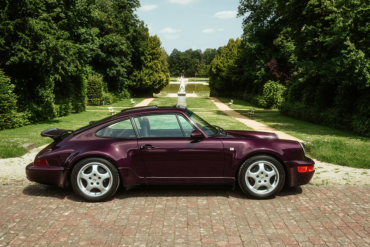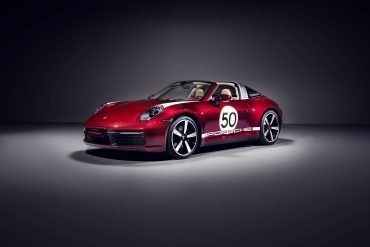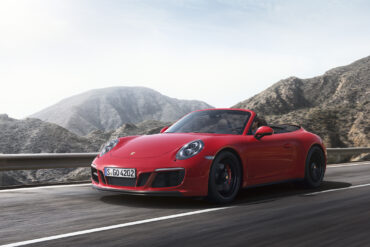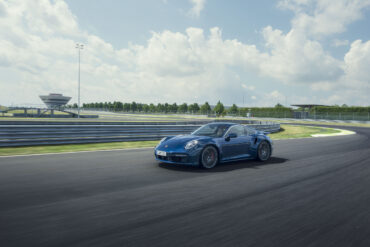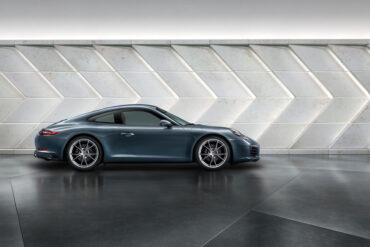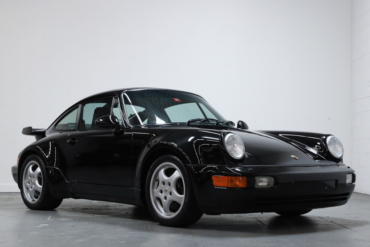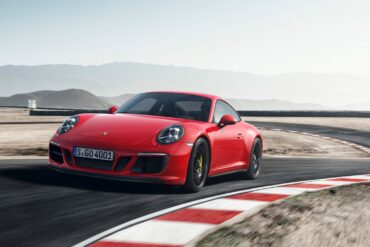The open-top 991 Carrera S Cabriolet requires an $11,600 premium over a comparable coupe; ta not-cheap $108,950 price point for those shopping. For that, you get the best overall open-top sports car around. With the 400-hp, 3.8-liter six and the benefit of the PDK automatic’s launch control, the Carrera S cabriolet should hit 60 mph in 3.8 seconds and cover the quarter-mile in the low 12s. Performance is on-par with the coupe on backroads so any fears that this is a soft-911 are thrown out the window. This is a serious sports car, sans roof.
The 964 based Speedster was the 1994 Speedster which was based on the 964 Carrera 2 platform. There are far fewer 1994 911 Speedsters in the world than the 1989 model, with production reportedly totaled only around 936 units, less than half as many as the 1989 example. Whereas the 1989 Speedster was primarily an aesthetic package, the 964 version sought a happy medium between the regular Carrera 2 and the hardcore Carrera RS. It had the same engine as the base Carrera and didn’t have the same suspension bits as the RS.
With the Turbo S, the PDCC Porsche Dynamic Chassis Control hydraulic roll bars came as standard. The PCCB Porsche Ceramic Composite Brakes had been standard on the Turbo S already since the 996 generation. New options included the radar-based lane change assist and a lift system for the front axle (increased ground clearance by 1.6″/40 mm). The PCM now had a multi-touch screen like in the facelifted 991 Carrera. Routes and places could be visualized with 360-degree images and satellite images. Engine gets more horsepower too, now with 572 bhp and 553 ft lbs of torque.
As with the previous 996 Targa model, the most striking feature of the car is the large, sliding-glass roof and glass rear hatch, which blend sleekly into the classic 911 lines while providing the Targa with its own unique personality. Like the rest of the range the Targa 4S got a visual refresh and the all-new direct injection engine. In the Targa 4S, it produced 380 bhp @ 6500 rpm and torque of 310 ft lbs @ 4400 rpm. 0 - 60 mph takes just 4.5 seconds (PDK) and top speed is 185 mph.
In recognition of the 50th Anniversary of the Porsche Club of America (PCA), Porsche has created an exclusive 911 Carrera' S Coupe model featuring a distinctive exterior color, unique interior styling and commemorative touches, and a more powerful and higher performing engine. Limited to an exclusive production run of just 50 cars initially made available to eligible PCA members, the 911 Club Coupe was unveiled this past weekend at PCA's 50th Annual Porsche Parade in Hershey, Pa.
For those who want more extreme performance, handling and track-day bragging rights, the RS is it. It's far from practical and may be too extreme for some, especially on the street, but on track it is exceptional. Only marginally quicker than the 991 GT3 that it is based on, but it delivers that performance with a different character. Massive grip, massive downforce and more extreme than the GT3. It delivers 80 per cent of the downforce of the full-on GT3 R race car, and with a carbon fibre bonnet and wings, a magnesium roof and polycarbonate rear windows and screen, it’s also light, weighing in at just 1,420kg.
The replacement for the SC series came in 1984 as the 911 3.2 Carrera, reviving the Carrera name for the first time since 1977. This was the last iteration in the original 911 series, with all subsequent models featuring new body styling and new brake, electronic, and suspension technologies. Almost the same galvanised body as the SC. Engine was claimed to be 80 per cent new, and the first production 911 to feature an ECU to control the ignition and fuel systems.
The 993 Turbo S, available between 1997 and 1998, bumped the power from the standard 993 Turbo up to 450hp (430 for the United States market) with larger turbochargers and a modified engine management system. The Turbo S was fitted with more luxury trim bits on the interior – with more leather and carbon fiber than on the standard Turbo. A larger rear wing was installed as well. Only 345 were built. Its direct successor was the 996 Turbo S for model year 2005.
For race teams and track day customers Porsche prepared a small number of the 964 Cup cars according to the FIA NG-T regulations. Officially called the Competition model, these custom-ordered cars were an intermediary step between the Carrera Cup option (M001) and the standard tourer (M002). This M0003 option was available directly from Porsche as a road-going model. These cars had almost all the Carrera Cup modifications including the new suspension. This lowered the car by 40mm in the rear and 50mm in the front. It also included fitting of the larger 930 Turbo disc brakes and adjustable anti-roll bars.
Along with its sibling Carrera 4, the 2005 Carrera 4S offered an all-wheel-drive system for the Porsche 911, but unlike the 4, the 4S gets the Carrera S' more powerful engine and it turns out that makes a big difference. The Carrera 4S was the more powerful and more dynamic version of the 997 Carrera 4 and an overall great sports car, especially for those in colder climates who need the safety of all-wheel traction. All rounder that fits nicely in the 911 lineup as perhaps the most practical.
The Porsche 911T continued as the entry level 911 for the 1970 and 1971 model years, sitting below the 2.2L 911 E and the 2.2 L 911 S. The 911 T featured all the upgrades that came with C-Series production updates including longer wheelbase and Fuchs alloy wheels. During its production years it was available as both a Coupe or Targa bodystyle. As with the E and S variants, Porsche would upgrade the 911T to a larger 2.2 liter engine.
The 2016 Carrera and Boxster Black Editions add some extra niceties for a value-adjusted price. And as the names suggest, both cars come in any color scheme you want so long as it’s, yes, black on black. Or black on black on black in the case of the ragtops. Available in coupe and convertible forms, with rear- or all-wheel drive, each powered by the base 350-hp 3.4-liter flat-6 engine, the 911 Carrera Black Edition adds other design treats too.
The 2014 50th Anniversary Edition 911 was built by Porsche to commemorate the 911’s birthday, 50 years after its production launch in 1964. In homage to 1963, the year the 911 debuted at the 1963 Frankfurt Motor Show, production was limited to 1,963 units. The 50th Anniversary uses the wider body from a Carrera 4S (but remains only rear-wheel-drive) and is lower than a standard Carrera by 10mm. The 20 inch-alloys are a modern take on the original Fuchs wheels, and the seats are finished in “Pepita” cloth. Includes Porsche Active Suspension Management (PASM), sports exhaust and powerkit tickled 430 hp flat six.
The second generation GT3 takes all that was good about it's predecessor and then improves it! Power from the GT1 derived flat-6 is up by 21 bhp to 381 bhp (with an 8200 rpm redline), ride height is lowered for increased stability and also has an upgraded braking setup, as it features a 6-piston calipers on the front. Two versions are offered, the more extreme 'Clubsport' showing it's track day colors with a full roll cage, racing seat and a 6-point harness. The 996.2 GT3 was the first GT3 marketed in the North America. The new Porsche 911 GT3 comes with all the features of half a century Porsche motorsport. It is a sports car for the purist through and through.
2012 Porsche 911 Carrera S Coupé The sixth generation 911 was revealed 2011 Frankfurt Motor Show as an all-new model....
The Targa was the half-convertible bodywork offered by Porsche for the 911. By removing only a part of the roof and leave the closed-coupe rigid structure. It was offered a better sensation than a sunroof and it wasn't as heavy as a convertible. Unlike the previous Targa generation, the 993 featured a glass panel over the front passengers instead of a fabric one. The rest of the bodywork looked similar to the Carrera. The engine was a completely reworked flat-six, with a 3.6-liter displacement with the VarioCam system, which offered 285 hp. It was mated either with a 6-speed manual or a 4-speed automatic.
Along with all the C-series improvements to the 911 line, the 1970 Porsche 911 S was upgraded to include a 180 bhp version flat-6. This further improved the performance credentials of the model which already had Fuchs light alloy wheels and bigger brakes. Specific to the S model's engine was a re-profiled camshaft, larger valves, better porting, higher compression and larger jets for the Weber carburetors. This resulted in 30 more horsepower for a total 180 horsepower.
This is the fastest convertible GT you can buy. The Turbo S cab gets 572 bhp (39 hp more than the base turbo cab) and 553 ft lbs (9 ft lbs more than the regular cab) of torque. With the Turbo S, the PDCC Porsche Dynamic Chassis Control hydraulic roll bars came as standard. The PCCB Porsche Ceramic Composite Brakes had been standard on the Turbo S already since the 996 generation. New options included the radar-based lane change assist and a lift system for the front axle (increased ground clearance by 1.6″/40 mm). The PCM now had a multi-touch screen like in the facelifted 991 Carrera.
Built so that the factory Rothmans Porsche Rally Team could hit the international stage, the SC RS used the Turbo’s body with fibreglass bumpers and aluminium doors. In Autumn 1983, Porsche presents the 911 SC/RS for motor racing. The engine originates from the 911 SC, with improved performance achieved by the mechanical ball fuel injection, increased compression, the cylinder heads from the 935 and forged pistons. Racing seats are fitted in place of the standard seats.
For the 997.2 generation, power from the 3.6-liter Carrera engine was increased to 345 hp while the Carrera S saw 385 horsepower from its 3.8-liter flat-six. Power was sent to the rear wheels via a standard manual box but for the first time, the 997.2 saw the introduction of the dual-clutch PDK as an option. The chassis remains largely unchanged, with slightly modified springs and dampers. The sports suspension is replaced with a variable, electronically controlled sports suspension based on the active PASM suspension. The sweet spot in the used car market at the moment.
The 911 GT America was based on the 991 GT3 Cup. It was built exclusively for the United Sports Car Racing (USRC) series and its GT Daytona class for 2014. While the GT3 Cup had a 3.8-litre engine at the time, the GT America was fitted with a 4.0-litre unit developing 351 kW. The main visual difference is the rear spoiler made to fit the USRC rules. Like the GT3 Cup, the GT America has 380 mm steel brake rotors at the front axle with 6-piston fixed calipers.
Porsche 911 Type 964 Carrera 2 'Works Turbo Look' Cabriolet was a special model in the 964 lineup. It gave buyers of the Carrera 2 Cab the great wide look of the Turbo cars and the Carrera 2 engine. The model was available as a 1992 and 1993 model year car (while some argue it was also available for a while in 1994). You get body shape of the 964 Turbo 3.3 without the huge rear spoiler. But this was more than just a design exercise, because the the Turbo-Look models also got the chassis and braking system from the Turbo 3.3 too.
To commemorate the 40th year of 911 production, Porsche built 1963 of the 40th Anniversary Porsche 911 Carrera for model year 2004. Painted only in a GT Silver Metallic finish, with a dark gray leather interior, the 40th Anniversary (or 40 Jahre in German) took the Base Model 996 Carrera and added the front fascia of the 996 Turbo, side skirts and luxury features for the cabin – including a luggage set that matched the special grey leather interior. Mechanically, the X51 Powerkit increases power to 341hp, combined with rear wheels power wheels, a standard 6-speed manual and sport suspension and limited-slip differential included.
In 2002, the standard Carrera models underwent a facelift. In addition, engine capacity was also increased to 3.6-litres across the range, with power up slightly on the naturally aspirated models. 2002 also marked the start of the production of the 996 based Targa model, with a sliding glass "green house" roof system as introduced on its predecessor. It also features a rear glass hatch which gave the driver access to the storage compartment. The 996 Targa is the rarest bodystyle in the series – only 5,152 were produced (all Mk.2 generation) between 2002 and 2005.
The Type 964 911 first launch with an all wheel drive model. It was a serious investment by Porsche in updating the chassis and tech platform. The 964 Carrera 4 was powered by the M64/01 3.6 liter flat six engine, developing 250 bhp and 229 ft/lbs of torque. The objective of the C4’s all-wheel-drive system was not only to provide improved traction but also better handling, especially in the wet and on slippery surfaces. The system sends power front/back in a 31:69 ratio because a 50:50 split would have made the 964 feel like a front-wheel-drive car.
To homologate the 1968 911 for competition purposes, Porsche began with the Spartan 911 T which were a full 54 kg (118 pounds) lighter than their 'S' siblings. Porsche offered clients the opportunity to buy a 911 T outfitted with competition equipment directly from the factory, and the resulting cars have become known as the 911 T/R. They were built in low quantities to a range of specifications depending on their intended competition purposes.
Designed as a grand tourer, the Porsche Carrera 4 Cabriolet was the base all-wheel-drive version for the open-top 911 range in 2001. It offered enough comfort to be used as a daily driver, on all weather. The 996 Porsche was facelifted in 2002. Along with the coupe versions, the convertibles were reshaped also. There was not a big difference on the outside. It was the same sports-car and open-top grand tourer. The Carrera 4 Cabriolet, continued on through 2004, receiving the same updates as the Carrera, including the 3.6-liter engine.
In 2002, the entire generation of the 996 was facelifted. The Carrera 4S Cabriolet was introduced in the lineup with the new engine and the Turbo bodywork. Many publications called the Carrera 4S the sweet spot in the 911 lineup when it was introduced, providing more performance than the base car without the exorbitant pricing of a Turbo or GT2. The Carrera 4S paired the aggressive bodywork and suspension of the Turbo with the base Carrera 4 drivetrain, though it didn't get the Turbo's huge rear wing. It’s easily identified by “Carrera 4S” badging and a large reflective strip on the rear end, spanning the gap between the taillights.
The heart of this most exclusive high-performance athlete is of course a six-cylinder boxer boosted by two exhaust gas turbochargers with variable turbine geometry, with an increase in power over the 911 Turbo by 30 to 530 bhp (390 kW). Maximum torque is a most impressive 700 Newton-metres (516 lb-ft). At the same time this new top model comes as standard with all high-tech components available only as options on the “regular” 911 Turbo. The 911 Turbo S comes exclusively with seven-speed Porsche-Doppelkupplungsgetriebe (PDK) conveying drive power to PTM all-wheel drive.
At the heart of the 991.2 911 Turbo is a twin-turbocharged flat-six with 540 horsepower and 523 pound-feet of torque. That’s a meaningful 20 more horses than the 991.1 Turbo. Improvements that come from increases in boost and fuel-injection pressures. Rounding the skidpad, the Turbo posts 1.02 g’s relatively easily. The wide P Zeros in back and the standard four-wheel steering conspire to hide the fact that 62 percent of the Turbo’s 3656 pounds sits over the rear wheels. With sport-plus selected, the 991.2 Turbo hits a 1.0-second run to 30 mph and a 2.6-second zero-to-60 time.
Introducing this new top-of-the-range model, Porsche is once again placing a 911 Turbo Cabriolet right at the top of the family after a break of 14 years: From 1987 - 1989 the Porsche 930, as the first Turbo was code-named within the Company, set the first milestone in the history of these outstanding open-air sports cars. With cylinders still featuring two valves each at the time, the 3.3-litre power unit driving the first Turbo Cabriolet offered maximum output quite unique at the time of 300 bhp or 221 kW. Acceleration from 0 to 100 km/h was in 5.2 seconds and the car had a top speed of 260 km/h or 161 mph.
Homologated roadgoing version of the ’97 911 GT1 Evolution racer costing $890,805 upon release. Twin-turbochargers were fitted to the M96/80 engine, which had water-cooled cylinder heads. Apparent from the front and rear lights, the GT1 shares many components with its series production counterparts, but puts them together in a more competitive way. Gone is the rear engine layout which isn't suitable for prototype GT racing, the GT1's turbocharged flat-six engine sits in front of the rear axle and is supported by chassis tubes instead of the typical 911 rear sub frame.
The 997 Targa design is the same as the 996s, with the power-operated panoramic sunroof and lifting rear window glass. The 997 Targa version's entire operation benefitted from thinner glass that cut approximately 4.2 pounds from its weight relative to the prior 996-series Targa. The 997 Targa 4 has softer spring rates than the coupe, a more generous helping of leather in the cabin, a better tally of standard equipment. The Targa 4 might therefore be all the 911 you ever want; not the fastest or the most visceral, but certainly the most complete car in a very impressive bunch. A great all-rounder.
The engine is the same 3.0-litre, twin-turbocharged flat-six petrol engine as in the 911 Carrera S, but it has been fettled to produce 473 bhp. The GTS also has a bespoke suspension set-up that sits 10mm lower than the standard 911, and that's true no matter whether you choose two- or four-wheel drive. Most of the time, there's absolutely no difference between the standard GTS and the all-wheel-drive version. But when you need it, the AWD Carrera 4 GTS will save you.
The flat six in the Carrera 996 was a newly-developed flat-six engine that offered 300 hp. It was mated as standard with a six-speed manual. A 5-speed automatic (Tiptronic) with manual override to shift gears was on the options list. As always, the Carrera 2 was rear-wheel-drive. Designed as a grand tourer, the Porsche Carrera Cabriolet was the base version for the open-top 911 range in 1998. The retractable roof was able to be stowed away in 20 seconds at speeds of up to 50 kph (31 mph), like the rest of the 911 convertible range. With the roof up, the car was tested in the wind tunnel at speeds of up to 338 kph (210 mph).
The Carrera 4 model also launched with a Cabriolet version in 1989 (for 1990 model year). The new 911 generation is introduced in Autumn 1988, but the convertible was not launched until the model year 1990. Alterations to the body include the bumpers and sill tread plates, and the 911 continues to be equipped with an automatically retractable rear spoiler and a cowled underbody. The braking system is fitted with ABS. The 911 (Type 964) also features power-assisted steering for the first time. Like the Coupe, the Cabriolet got the new all-wheel drive system.
Sticking to their strengths, Porsche has created the most sought after car in its line-up, the 2017 Porsche 911 R. We have seen numerous rumors about this car for a couple of months now and this time we finally get to see it. The new Porsche 911 R with 4-litre naturally aspirated flat-six engine with a six-speed manual gearbox is coming to us for sure. It's lighter and faster with its engines pumping out 493 bhp at 8,250 rpm and 333 lb-ft at 6,250 rpm. The result is probably the best 911 of the modern era. Porsche at its finest.
In 1974 Porsche offered a high performance fuel injected Carrera specifically for the European market. These were close to 2.7 RS specification and are often referred to as the 2.7 or Euro Carrera. In many regards, this car is similar to the 1973 2.7 RS in touring trim, with its 210bhp 911/83 engine, but the 2.7 Carrera is based on the updated G-series body and interior. Later Carreras that reach American shores used had reduced power and throttle response compared to Euro counterparts.
The Porsche 911 GT2 Evo represented the top specification ever produced for any air-cooled Porsche. Designed to compete in FIA GT1, it incorporated a twin turbocharged 3.6L flat-6 engine rated at a full 600 HP and 491 lb-ft of torque. As compared to the standard 993 GT2, Porsche widened the rear fender extensions to cover wider modular wheels and added a new front spoiler with inlets for oil and brake cooling. A second deck appeared on the already outlandish rear spoiler, which could be mounted higher in the air stream for added downforce. Approximately 11 samples were produced.
With all-wheel drive and all the GTS goodies, the Carrera 4 GTS sits in a very practical place in the Porsche 911 lineup. The 4 GTS is a Carrera 4S with all the items Porsche thinks you should have at a price that is less than choosing them yourself. Standard equipment on the GTS that is normally optional on the Carrera S includes the Sport Chrono Package, Sport Exhaust, bi-xenon lights with PDLS (Porsche Dynamic Lighting System) and PASM (Porsche Active Suspension Management). Inside, four-way adjustable sport seats are standard.
The Carrera 4 Cabriolet gets that wonderful extra-wide body and an AWD system hooked up to its new turbocharged 3.0-liter flat-six engine. Additionally, the Carrera 4 Cabriolet gets a spate of new goodies, including a unique taillight section, and an updated infotainment system that brings the sports car’s connectivity to a whole new level. The open top Carrera 4 does a great job as an all-rounder, giving drivers the all-weather assurance of all-wheel drive and combining it with open top driving fun. Dynamically, it is up there with its coupe sibling.
Porsche added the rear wheel drive Carrera 2 variant to the range in 1990. It was developed alongside the 964 Carrera 4, Porsche waited a year to release the Carrera 2 as a 1990 model year car. Like the Carrera 4, the Carrera 2 was available as a coupé, Targa or Cabriolet. Overall, the Carrera 2 packed almost the same technical specifications as the Carrera 4 model. The engine was the same 3.6 liter unit which produced 250 horsepower and a maximum speed of 162 mph. Looked like C4 but was 200 lb lighter and more fun to drive.
If the 996.1 911 GT3 was all about the engine, in the 997.1 completes the rest of the formula. The surgical clarity of its transmission, steering, brakes, pedal weights and heights, and overall chassis balance represented a clear step-change from its regular 997 911 siblings. But the engine was still the heart of the car, the water-cooled 3.6-liter flat-six boasting a new intake and a new exhaust compared with the 996 versions. Official output was 415 hp, though insiders admit some engines made close to 430 hp. Launched in 2006, today this is in many ways the sweet-spot GT3, way more affordable than the later 4.0.
The Porsche 953 ranks as one of the finest off-roaders Porsche has ever made. It was basically a souped-up 911 designed specially to give Porsche an advantage in the 1984 Paris–Dakar Rally. Just a year later, it was replaced by the 959. Despite its brief run, it still managed to make quite the impression. Built around a massively enhanced suspension and a supremely powerful 300 bhp (224 kW), 6-cylinder engine, it showed Porsche knew more than just sportscars.
As a successor to the Carrera 2.7 MFI, the Carrera 3.0 was fitted with a variation of the 930's engine without a Turbo. During its production period only 3,687 cars were made. The Carrera 3.0 was replaced by the Porsche 911 SC for model year 1978. Between 1976 and 1977, Porsche introduced the Carrera 3.0 with wide rear flares, optional whale-tail, and other luxury options. Built before the ‘911 SC’ it has everything the SC has, and more. It’s a different drive with more power @200bhp; more torque @188 ft/lb @4200rpm and it was 10% lighter too.
The Porsche 911E continued as the midrange 911 model for 1972 and 1973, fitting between the contemporaneous 2.4L 911T and the 2.4L 911S. As with the T and S variants, Porsche would upgrade the 911E to a new, larger 2,341 cc (2.3 L) engine, commonly known as the "2.4 L" engines. The 911E version, designated 911/52 was rated at 165 hp (it was designated 911/62 with Sportomatic). With the power and torque increase, the 2.4-liter cars also got the newer and stronger transmission.
The new Porsche 911 Carrera 4 unites the excellent performance and efficiency of the new generation of the 911 Carrera with the dynamic benefits of the latest version of the active all-wheel drive system PTM (Porsche Traction Management). The typical Porsche all-wheel drive with rear-focused layout in this latest 911 version guarantees maximum vehicle dynamics on a wide variety of road surfaces and in all weather conditions. The new 911 Carrera 4 models deliver traction and dynamic performance the power of four.
The Turbo-look Porsche 964 has always been a very desirable automobile, among them 1,532 Carrera 2 Cabriolets constructed worldwide. Within that group, there were some cars that were even more specialized. The Register says six Turbo-look cabriolets were pulled off the production line in Zuffenhausen and transported to the Porsche Exclusive shop in Weissach. Three of these six powerful and luxuriously equipped drop-tops were equipped with left-hand drive for buyers in Germany (Code C00), and the other three were fitted with right-hand drive
If the base 911 coupe doesn't do it for you, maybe the Carrera S coupe gets you over the line. For about $20k more, you get more horsepower, torque vectoring and bigger wheels. The Carrera S uses a version of the 3.0L twin-turbo flat-6 that generates 443 hp and 390 lb-ft of torque. Torque vectoring allows different amounts of torque to be distributed between drive wheels on the same axle. This means the inside wheel can turn slower than the outside wheel for improved cornering.
In 1999, Porsche celebrated the turn of the century with a special edition – the 996 "Millennium Edition". The 911 Millennium edition was based on the Carrera 4 coupé and was pretty rare, with only 911 cars made. Based on the Carrera 4, the "Millennium Edition" was limited to 911 examples and was based exclusively on the wide bodied Carrera 4. This special edition was finished in Violet Chromaflair paint, which, depending on the light changes from dark violet to light green and is quite spectacular to look at. It also got a caramel-colored leather interior and polished "turbo-twist" wheels.
Features like Porsche’s active suspension and the new-for-992 “wet mode” are standard on the Carrera 4 variants, but the electronically controlled limited slip rear differential (standard on the 4S), as well as ceramic composite brakes (cast iron rotors are standard). The current 911 Carrera 4 Cabriolet is equipped with PASM (Porsche Active Suspension Management). The twin-turbo flat-six has 379 hp and 331 ft lbs of torque.
In 1980, a true limited edition model 911SC was produced for the American market. The 'Weissach' edition was a standard SC with special paint. It was built in 1980 to honor the Porsche Motorsport team working in Weissach Germany. 468 units were made and half were painted Metallic Black, the other half in Platinum Metallic. The interiors were wrapped in Doric Grey leather with burgundy piping. Additional body and mechanical specs included whale tail spoiler, Bilstein dampers and Fuchs wheels.
Like the rest of the range the Carrera S Cabriolet got a new 997.2 generation update. Not much is new on the outside, but the design refresh did give it a revised front bumper and larger air intakes, as well as by new large mirrors and the bright strip of LEDs below the headlights that serve as daytime running lights. Inside the car, there's a new communication management system, PCM 3.0 which includes a new touchscreen feature, is standard on all 2009 and onward 911s.
Porsche made a lightweight version of the Turbo simply known as the Tuubo S. This used the spartan appointments of the Carrera RS with an upgraded version of the Turbo engine. Some cars received graphics on the side celebrating IMSA Supercar Championship. Similar to the Carrera RS, the Turbo S had no power steering, air conditioning, airbags, central locking, alarm system, rear window wiper, smaller window washer reservoir, smaller horn, and had thin-gauge glass. The engine used a second oil cooler and slightly higher boost to improve overall performance.
The 996 GT3 R was a one-year-only (2000 model year) special of which only 63 were produced. The car took the basic GT3 bones and amplified it for motorsport. The Mezger engine produced over 400 horsepower, while factory-fitted adjustable shock absorbers gave better handling. Most notably, the GT3 R wore carbon-fiber bodywork meant for ultimate light weight in motorsport. The 996 GT3 R was introduced in 1999 as a replacement for the 993 RSR. Before its introduction, it was extensively tested at Weissach and Paul Ricard. In the 2000 FIA GT Championship, the 996 GT3 R was in the N-GT class and won every run. Won the 24-hour race at the Nürburgring.
Porsche introduced the 991 GT3 for the 2014 model year, as follow up to the multiple 997 GT3 variants. The 991 GT3 featured a new 3.8 litre direct fuel injection (DFI) flat-six engine developing 475 hp (354 kW; 482 PS) at 8,250 rpm, Porsche's Doppelkupplung (PDK) double-clutch gearbox, and rear-wheel steering. The 911 GT3 is claimed to be able to accelerate from 0-60 mph (97 km/h) in 3.1 seconds or less, and the quarter mile in 11.2 seconds at 126 mph (203 km/h). It evolved into the 991.2 GT3 for model year 2018.
Porsche has also decided to gift the GTS a more distinct and dynamic personality that can’t be duplicated via the Carrera S’s options list (even if you could get the engine, which you cannot). The downside is that the price has gone up too and ticking a few more options boxes can get the Carrera 4 GTS Cabriolet into 911 Turbo territory price-wise. In the engine department, the 3-litre twin turbo flat six develop 473 bhp and 420 ft lbs.
Porsche purists might moan that the flat-six engine in the rear is no longer naturally aspirated, but with more power and torque, improved efficiency and some advanced interior tech giving this 911 an even bigger breadth of ability than before, this facelifted 991-generation model carries on where the old car left off. Sure, it’s lost a touch of that high rev zing from the old car, but if you add the sports exhaust, the bark from the engine inside and out is still intoxicating. And so is the speed. The 991.2 Carrera S is absolutely amazing on both road and track and still the best sports car around.
The 911 Turbo was put into production in 1975. While the original purpose of the 911 Turbo was to gain homologation for the 1976 racing season, it quickly became popular among car enthusiasts. Ernst Fuhrmann adapted the turbo-technology originally developed for the 917/30 CAN-AM car and applied it to the 3.0 litre flat-six used in the Carrera RS 3.0, thus creating what Porsche internally dubbed as the 930. Total power output from the engine was 260 bhp and 254 ft lbs of torque.
The 911T Coupe and Targa continued as the entry level 911 for 1972 and 1973. As with the higher-end E and S variants, Porsche upgraded the 911T to a new, larger 2.3 L engine, commonly known as the "2.4 L" engine. With the power and torque increase, the 2.4-liter cars also got the newer and stronger transmission. Non-US versions (ROW), were carbureted and featured the Type 911/57 engine, rated at 130 hp. US-spec 911T's had engine Type 911/51 and were rated at 140 hp.
Introduced in 1989 (the year of the 911’s 25th anniversary), the 964 Carrera 4 was a significant new model for the company, but the 4-wheel drive system was deemed unsuitable for the company’s racing series. Manufactured alongside the Carrera 4 at the same time was the more traditional rear-wheel drive Carrera 2, but this model’s launch was only planned for a year later, in the hope that it would not detract from potential sales of the Carrera 4. The 1990 season was the first season that saw the 911-based model become the pillar on which the Porsche Carrera Cup series has been established.
Model year 1994. Carrera 4 Wide-Body for the U.S. Technically there is really no difference between the Carrera 4 Wide-Body and his RoW counterpart. At the front there are the for America usual black impact absorbers beside the fog lights, the frontfenders lack the side indicators, the rear bumper is equipped with the center piece with a small plate section and in the back window of a large third brake light is integrated. Significant differences, it is generally provided in the factory standard equipment.
To celebrate 60 years of Porsche Club of America, PCNA (Porsche Cars North America) ordered 60 units of 911 Carrera GTS Coupés in Club Blue from Porsche Exclusive. All 60 cars were equipped with SportDesign aerokit (including ducktail). These Club cars were not numbered because it wasn't a special series by Porsche AG, but a series of similarly equipped cars ordered by PCNA. The cars got a few unique touches by Porsche Exclusive, like the special "Club Blau" paint, the "Club Coupe" stickers on the doors, the door entry guards with ''GTS Club Coupe" lettering and number "60" embossed on the armrest cover.
2013 Porsche 911 Turbo Cabriolet Stuttgart. The dynamic range of the new 911 Turbo models1) multiplied by the driving pleasure...
Introduced in late 1994 the standard 911 Carrera of the 993 generation was fitted with a development of the M64 3.6-liter flat six that had been found in the prior 964 generation. With a redesigned exhaust system and new hydraulic lifters, the engine produced 272 horsepower. For the 1996 model year, a Targa variant was introduced, and a variable intake runner system (called VarioRam) was added to the entire Carrera lineup, bumping horsepower to 285. Approximately 23,000 coupes were built, 15,500 cabriolets, and 4,500 Targa's, in both manual and automatic (Tiptronic) transmission. Overlapping with the last year of production, it was replaced by the 911 Carrera of the 996 generation for model year 1998.
The 996 GT3 RS was a sharpened version of the Mk.2 GT3, built for track use and it was the homologation model for the GT3 race-car. It was the forbidden fruit for the U.S. and Canadian customers. It was available in a limited number and it was a true track-oriented vehicle. It was based on the GT3 version, but with fewer comfort features and even stiffer suspension. It was the kind of car which could have been taken from the shop and dive into the first race-track. The GT3 was available in white color only, with red or blue inscriptions on its sides. The adjustable rear wing and the “duck-tail” were mounted in the back, to provide better traction on higher speeds. It was fitted with the same engine as the GT3.
Slantnosed and based on that of the 935 racecars, with pop-up headlamps. The front spoiler was made deeper in order to accommodate the extra oil cooler, while intakes in the rear wings fed air to the brakes. The larger turbocharger and four-outlet exhaust gave 30bhp of extra power. Porsche began their “special order program” offering a Flachbau option (Slantnose) for the 930 in very limited production. All of this at a cost of nearly 2 times the standard 930S.
In contrast to the 911 Speedster from the 1989 model year, the 964 Speedster was only offered and produced with the narrow body shape. In December 1991, the first wide bodied prototype based on a 964 Carrera 2 Convertible Turbo-Look was registered at Porsche AG, but it never made it ready for a series production. In response to recurring customer requests for Turbo-Look Speedsters - the optical characteristics of the wide body in combination with the flat windscreen and fiberglass cover had found many fans - Porsche converted the previously individually ordered, narrow Speedster in the exclusive department.
The Porsche 911 Carrera S Cabriolet also features a heated glass rear window and integrated magnesium support elements. The automatic fabric top opens and closes at speeds of up to 31 miles per hour in just 12 seconds – one second quicker than before. The 992 Carrera S Cabriolet gets a twin-turbo 3.0-liter flat-six with 443 bhp and 390 ft lbs of torque. That is 29 more horsepower and 22 more ft lbs of torque than the outgoing model.
The rarest 964 RS variant was the awesome 964 C4 Lightweight. Known as the 964 Leichtbau it made use of surplus parts from 953 Paris-Dakar project. A handful of specially prepared lightweight 911s were fabricated by the Porsche factory and called the Carrera 4 RS Lightweight. Carrera RS Body with 959-like AWD wizardry and more power. Lightweight masterpiece. Used parts from 953 Paris-Dakar project. The 964 C4 Lightweight was powered by the same 3.6 liter flat six as the normal 964 RS, but was fettled to produce 300 hp.
Porsche refers to it as a new generation, even though the internal chassis code 997 remains unchanged. The 997.2 therefore is more of a mid-term facelift with some significant technological changes. Notably, the water-cooled flat-six engines get direct-injection technology, and a seven-speed, dual-clutch transmission replaces the previous five-speed Tiptronic automatic while the shift-it-yourself option remains a six-speed. Base Carrera coupe gets 339 bhp and 287 ft lbs and a 0.3 second faster 0 - 60 mph time of 4.5 seconds. Top speed now 179 mph. A nice update indeed.
Towards the end of the 1996 season, Porsche made revisions to the 911 GT1 in preparation for the 1997 season. The front end of the car was revised including new bodywork which featured headlamps that previewed the all-new generation of the (996) Porsche 911 which would be unveiled in 1997. It had the same engine as the previous version, but new aerodynamic elements allowed the 1997 version to be considerably faster than the 1996 version. At Le Mans the works cars led the race but did not last the full distance; a privately entered 1996 specification GT1 managed 5th overall and third in its class.
Henry Catchpole drives the 991.2 Porsche 911 GT3 RS in search of the forgotten Sudschleife circuit....
Porsche 911 Turbo (992) Earlier this year, Porsche revealed and released the 2021 model year Type 992 911 Turbo S,...
In 1978, the works team fields two 911 SC at the East African Safari Rally. The name of game is to survive 5,000 kilometres of the toughest tracks in sweltering heat and torrential rain. The conditions take their toll: of the 72 starters, 13 reach the finish line. Martini Racing Porsche System Engineering signs on two specialists to drive: Sweden’s Björn Waldegård (Start No. 5) and Kenyan Vic Preston Jnr (Start No. 14).
The current Turbo S comes with an all-new, 3.8 liter boxer six with two variable turbine geometry (VTG) turbochargers. The power output is a staggering 640 HP and 590 lbs-ft of torque. In keeping with previous Turbo models, the engine powers all four wheels. A new 8 speed automatic transmission with a manual mode manages the power, and can power the car to 60 MPH in a hair under a claimed 2.6 seconds. This is a staggeringly quick and capable car.
The 996 Carrera 4S Cabriolet is the convertible version of the slightly-uprated 996 Carrera 4. Introduced a year after the 996 C4S Coupe. The Carrera 4S Cabriolet was introduced in the lineup with the new engine and the Turbo bodywork. The cabriolet version of the Carrera 4S paired the aggressive bodywork and suspension of the Turbo with the base Carrera 4 drivetrain, though it didn't get the Turbo's huge rear wing. The three-layer canvas-top was powered and it needed 20 seconds to completely retract or cover the car, at speeds up to 50 kph (31 mph). For winter, the car featured an aluminum hard-top.
Porsche will only build 30 examples of the Clubsport 25. Mechanically, it's similar to the regular GT2 RS Clubsport. It makes the 691 horsepower from a twin-turbocharged 3.8-liter flat-six. But it gets many, many changes to the exterior and even the cooling system. As you can clearly see, the body has been lengthened, and it has also been widened. The latter is necessary to house the wide, low-offset 18-inch wheels taken from the Porsche 935, though without the aerodynamic covers.
A 911 for the road and track – the new Porsche 911 GT3 Stuttgart. The Porsche 911 GT3 delivers motorsport-like performance,...
Porsche developed the S/T, of which 33 were built in 1970 and 1971, taking full advantage of new FIA rules allowing a two-inch wider track. Accordingly, wheel arches were widened to accommodate seven-inch front and nine-inch rear wheels. Weight reduction was even more radical, including thinner-gauge steel for the roof and floorpans. Heating ducts, seat slide supports, the glove-box lid, ashtray, sun visors and rear torsion-bar covers were deleted.
Like the 911 Turbo Coupe, the 997 Turbo Cabriolet is powered by a 3.6 liter six-cylinder boxer engine with biturbo turbocharging and Variable Turbine Geometry (VTG). The powerplant already generates 480 hp (473 bhp) and 460 ft lbs of torque at 1950 rpm. The manual transmission version can accelerate from 0 to 100 km/h in just four seconds while the Tiptronic S the time can be cut to 3.6 seconds. Top speed for the Cab is the same 193 mph as Coupe and only weighs 70 kilos.
The 997 Carrera S was the first step up in performance over the base 997 Carrera. Available over two distinct generations, the 997.1 Carrera S used a 3.8-liter engine producing 355hp – the available X51 Powerkit bumped that number to 376hp. From 2009 onwards, the 997.2 Carrera S offered 380hp from 3.8 liters. Besides a more powerful engine, it also comes standard with 19 inch wheels, larger brakes, and a lowered suspension with PASM.
The 993 Carrera RSR takes the 993 Carrera RS formula and makes it even more track-ready by adding a roll-cage and removing carpet, power windows, and a/c. There were just thirty Porsche 911 Cup 3.8 RSR (Type 993) race cars produced for the 1997 season. This model was the last of the breed of air-cooled, naturally-aspirated 911 race cars to come from the Weissach race department before the introduction of the Type 996 water-cooled cars. To find a 993 3.8 RSR that participated in some of the world’s toughest endurance races in period, and survived unscathed and unmolested, is quite rare.
The GT2 RS's reputation as the most powerful street-legal car is as monstrous as this comprehensive guide. Suffice to say, this supercar has been built with the best Porsche has to offer. It's not bragging, it's just facts. There is no doubt that the new GT2 RS is the pinnacle of the 911 in terms of performance. It is simply the fastest 911 in history, and that’s a fact. It is the quickest production car to lap the Nürburgring Nordschleife. It is the most powerful 911 ever made.
The two 997 Targa 4 cars are both offered in only all-wheel-drive. Available with either a 3.6 litre flat 6 in the Targa 4, or with a more powerful 3.8 litre flat 6 in the Targa 4S, the new car offers almost all the fun of a convertible without sacrificing the dynamic abilities of a hardtop. The Targa 4S gets to 60 mph in 4.7 seconds and tops out at 179 mph thanks to its 3.8 liter flat six pumping out 350 bhp and 295 ft lbs of torque. It has softer spring rates than the coupe, a more generous helping of leather in the cabin, a better tally of standard equipment, more storage space behind the front seats.
For 2009, engine power is distributed to all four wheels via the same electronically controlled Porsche Traction Management system found previously only on the Porsche Turbo. The electronic controls respond to driving conditions even more instantaneously than the previously used hydraulically activated all-wheel drive system. The Carrera 4S model, with a 3.8-litre engine developing 355 bhp, can go from 0 to 60 mph in 4.5 seconds and has a top speed of 185 mph.
The GT3 was based on the standard 996 Carrera, but was stripped of a great deal of equipment for weight savings, featuring stiffer, adjustable suspension and upgraded brakes. The GT3 used the bodyshell of the four-wheel-drive Carrera 4, which incorporated additional front-end stiffening. It featured a naturally aspirated 3.6-litre flat-six engine generating a maximum power output of 360 bhp @ 7200 rpm and torque of 273 ft lbs @ 5000 rpm. This engine was shared with the 996 Turbo and was a derivative of the engine developed for the 911 GT1 race car.
The Carrera S was the ultimate, naturally aspirated version of the Carrera 2. Porsche decided to offer something more to its customers when it launched the Carrera S version. It featured a stiffer and lowered suspension. Its wider tires made it better in the corners and faster around a race-track than its Carrera 2 sibling. The Carrera S took its bodywork from the Porsche Turbo. But it didn't get the turbocharger or the all-wheel-drive system. Its wider rear fenders and lowered stance than the Carrera lineup made it a desirable car for the Porsche fans. The engine was the same 3.6-liter naturally aspirated, but it was offered in the higher power output of 285 hp. The only transmission available was a 6-speed manual.
The optional X50 Performance Package gave the base Turbo larger K24 turbochargers and intercoolers, a revised ECU and a quad-pipe exhaust, raising the engine’s output from 415 to 450 bhp and maximum torque from 415 to 457 ft lbs. With power at 450 bhp @ 6000 rpm and torque of 457 ft lbs @ 4400 rpm, the X50 option is a monsters. Porsche engineers achieved the increase in power and performance through modifications to the Turbo charger, the change air cooler, the control units and exhaust system in particular. The base constructions of the manual and automatic transmissions were also improved.
The first generation of the Porsche 911 begins in late 1964 and goes through 1968. The "base" model was an instant hit. During this period, Porsche would make continuous improvements and tweaks to the body, to its short wheelbase (SWB) chassis, and to its 2.0 liter flat six engine. Model year 1968 would be the last for the early 911, a transition that would begin with the introduction of the higher output 911S in 1967, followed by the 911L and a new entry level 911T in 1968, and finally, the 911E in 1969. The base 911 was available as both a Coupe and Targa (starting in '67).
2,500 cabriolets were made in the 993 Carrera 4. The 993 Carrera 4, sold between 1995 and 1998, uses the same powerplant as the standard 993 Carrera, but puts power down to all four wheels through a 6-speed manual transmission. A “Carrera 4” badge on the tail, along with silver-painted brake calipers and clear front and side turn signals, help distinguish the all-wheel drive C4 from the C2 sibling.
Finally, in 1982 the model 911 SP 'Ferry Porsche' was introduced as a special edition to celebrate 50 years of Porsche. This special edition was finished in Meteor metallic paint with burgundy leather interior and a 'Ferry Porsche' signature on the headrests. Only 200 of these now-classic special cars were built (130 Coupes and 70 Targas). The 911 SC “Jubilee” or “Ferry Porsche” is the first “limited series” sold in Europe.
The 993 Carrera Cup 3.8 was developed from the 993 Carrera RS, as purpose-built competition car designed by Porsche for its single-model racing series taking place around the world. Replacing the 964 Carrera Cup, the 993 Carrera Cup had a claimed 315 bhp on tap, weighed only 1,100kg, and offered a top speed of around 270km/h (170mph). Approximately 216 samples were built. The Carrera Cup should not be confused witth the Carrera RSR, or the 993 Carrera RS Clubsport version.
In March 1993, Porsche presented the Porsche 911 anniversary model “30 years 911” at the Geneva Motor Show. Since then, the special model is also called “Jubi” for short. Under the Porsche internal code M096, there is essentially a Carrera 4 with the wide turbo body but without wings. The 964 anniversary edition could be ordered with exclusive interior design and numerous possibilities of customization. According to Porsche, the special model was limited to 911 vehicles and manufactured in the model years 1993 and 1994.
The Porsche 911 Targa 4S Heritage Design Edition showcases what is possible with Porsche's Exclusive Manufaktur program and what to expect from Porsche's Heritage Design Strategy. Inspired by the 356 and previous generations of the 911, Porsche's Heritage Design Strategy is bringing period-correct design cues into the current 992 generation 911. Cherry Metallic is the stunning color. Limited to just 992 units globally.
The GTS 4 Cabriolet reminds us how awesome Porsche cars are. This is a 911 that can be used as a regular car, an all weather convertible 911 that does everything really well. And when you want to push hard, the car transforms into a true sports car, a car that no enthusiast will ever complain about. Drop-top 911s have always played a supporting role to the fixed roof versions, but in GTS specification the Cabriolet is now better than ever.
It would be a disservice to call this new Turbo a "lesser" car than the Turbo S, but it does have less in most departments. Less power at 573 HP. Less features compared to the jam-packed Turbo S. Most importantly, less money required to put one in your garage. This also is not to say that the new Turbo isn't anything short of a monster. It will still go 0 to 60 in 2.8 seconds, will corner like it was on rails with Porsche Torque Management (PTM) all-wheel-drive.
The 991.2 generation Carrera range update was a big one. The base coupe looks about the same, but under the hood Porsche did something crazy. Gone is the 3.4 liter naturally aspirated flat 6, replaced by a 3.0 turbocharged flat six. The good news is that the new engine is pumps out 370 hp and 331 ft lbs of torque, a big leap over the previous generation (output is up over the previous car by 20 horsepower and 44 lb-ft of torque). Inside, the updated 911 hasn’t changed dramatically, and although Porsche’s new PCM infotainment system is faster and more intuitive to use.
A forgotten part of the 964s history is the Turbo S2. It was built to adhere to homologation rules so Porsche could participate in IMSA's sports car racing series. IMSA's homologation rules meant that Porsche had to build at least 200 road-going versions of the participating car, 20 of which needed to share most of the primary components of the race car. The 911 Turbo S2 was built specifically for this purpose and exclusively for the United States and Canada. The 20 homologation specials left the factory as stock 964 Turbos, heading immediately to California-based tuner for "S2" engine upgrades.
The GTS coupe starts with the wider Carrera 4 body, with the rear fenders pushed out 1.7 inches, and the rear track widened 1.6in. Up front is the new SportDesign front fascia with its lower front spoiler and larger cooling air intakes. Standard wheels are 20-inch center lock items and 0.5 inch wider than standard Carrera S rims, finished in satin black. There are splashes of black elsewhere, too. The changes run more than skin deep. Bigger turbos pump up to 18psi of boost pressure which helps deliver not only 30 extra horses at 6,500 rpm, but 405 lb-ft of torque between 2,150 rpm and 5,000 rpm, up from 368 lb-ft. This is the sweet spot.


